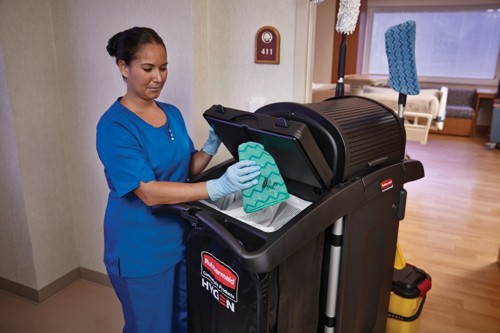
Infection prevention in healthcare settings is necessary to ensure patients recover quickly and that Hospital Associated Infections (HAIs) do not transmit throughout the premises. However, more than just cleanliness, healthcare facilities need to consider their ergonomic cleaning needs. This is because a lack of ergonomics can interplay into a business's finances, reputation and employee turnover, particularly due to work cover costs and the price of missed work.
Therefore, the following blog discusses the range of ergonomic cleaning products from the Rubbermaid Commercial Products range and how these products can improve cleanliness, sanitisation and worker safety.
The Challenge of Cross-Contamination in Healthcare Environments
Healthcare settings handle patients with multiple conditions, some of which are more infectious than others. For healthcare workers, this means they need to alleviate the chances of cross-contamination to guarantee that patients, guests and staff do not fall ill or contract new infections.
Some ways to prevent cross-contamination include:

Minimising the Risk of Infection with Ergonomic Cleaning Tools
Ergonomic cleaning tools intend to make it easier for employees to clean. This may be due to a handle that sits in the hand properly or a cleaning cart that can be adjusted to meet the height of the employee using it. Though, they also have other benefits. Through ergonomics, infection prevention also becomes easier, meaning there are more benefits than simply guaranteeing employee health and safety.
Primarily, this is because ergonomic cleaning materials and equipment are easier to use correctly. For example, a cleaning cart allows staff to carry all their dirty and clean hospital bed linen to where it needs to be. This is an alternative to carrying dirty linen in their arms or a bag, which can transmit pathogens onto clothing or other surfaces. As another example, brooms and dustpans have been innovated to not require excessive bending to use. This makes them more comfortable to utilise, which can guarantee that dust, debris and waste are not missed as they can become hubs for bacteria and harmful pathogens.
Training and Support Services for Effective Infection Prevention
While ergonomics sits wildly around how products are designed, this is not the only way good ergonomics are achieved. Staff may have the most innovative products on the market from the Rubbermaid Commercial Products range. However, if they are using equipment incorrectly, this can render their processes ineffective. For example, holding a mop in the incorrect location can limit its range, which may slow down the cleaning process or leave specific patches on the floor uncleaned. In this sense, cleaning and sanitisation in healthcare won’t be as effective as intended, which can then lead to the spread of harmful viruses.
Therefore, staff must be trained on how to use all ergonomic cleaning equipment to not eliminate its effectiveness. Fortunately, the Rubbermaid Cleaning products portal has a range of training videos and resources to guarantee equipment is utilised effectively. This ranges from wiping from right to left with Rubbermaid HYGEN Microfibre to the correct way to use waste bins. Explore the cleaning products training portal here.
Ergonomic Cleaning tools don’t require excessive chemicals
Healthcare facilities will often rely on the use of chemicals to guarantee that facilities are as clean and infection free as possible. However, the ergonomic and innovative range at Rubbermaid Commercial Products can clean effectively, just with the use of water.
Ergonomically, this means that cleaning staff are not potentially constantly exposed to harmful chemicals which can have negative impacts on their airways. Instead, staff can use discretion on when cleaning chemicals are required and when they aren’t.
For example, the space above a cupboard may be suitable to clean and sanitise without using heavy chemicals. Whereas a bathroom that has been exposed to faecal waste will likely require heavier cleaning. 

Rubbermaid Commercial Products is here to supply ergonomic infection prevention equipment for healthcare businesses
The team at Rubbermaid Commercial Products understands how ergonomic cleaning solutions can make infection control a simpler process. Contact the team today to learn about the range of available solutions and how this can benefit your healthcare business. Alternatively, you can explore the online range at any time by clicking here.